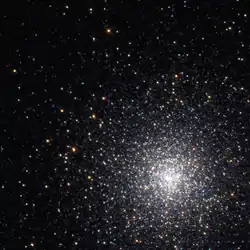| NGC 5824 | |
|---|---|
 NGC 5824, imaged by the Hubble Space Telescope | |
| Observation data (J2000 epoch) | |
| Constellation | Lupus |
| Right ascension | 15h 03m 58.6s[1] |
| Declination | –33° 04′ 07″[1] |
| Distance | 104.4 kly |
| Apparent magnitude (V) | 9.09 |
| Apparent dimensions (V) | 6.2' |
| Physical characteristics | |
| Metallicity | = –1.60[2] dex |
| Estimated age | 12.80 Gyr[2] |
| Other designations | ESO 387-SC 001[1] |
NGC 5824 is a globular cluster in the constellation Lupus, almost on its western border with Centaurus. Astronomers James Dunlop (1826), John Herschel (1831) and E.E. Barnard (1882) all claim to have independently discovered the cluster. It is condensed and may be observed with small telescopes, but larger apertures are required to resolve its stellar core.[3][4]
A stellar stream, known as the Triangulum stellar stream, is thought to have originated from NGC 5824. It is located quite far from NGC 5824 and is part of its leading tail. Meanwhile, its trailing tail has also been detected, spanning about 50 degrees through the sky.[5]
References
- 1 2 3 "NASA/IPAC Extragalactic Database". Results for NGC 5824. Retrieved 2007-04-06.
- 1 2 Forbes, Duncan A.; Bridges, Terry (May 2010), "Accreted versus in situ Milky Way globular clusters", Monthly Notices of the Royal Astronomical Society, 404 (3): 1203–1214, arXiv:1001.4289, Bibcode:2010MNRAS.404.1203F, doi:10.1111/j.1365-2966.2010.16373.x, S2CID 51825384.
- ↑ "NGC 5824 [Archive]". Retrieved June 18, 2011.
- ↑ "Deep-Sky Wonders". Sky & Telescope: 226. August 1992.
- ↑ Yang, Yong; Zhao, Jing-Kun; Ishigaki, Miho N.; Chiba, Masashi; Yang, Cheng-Qun; Xue, Xiang-Xiang; Ye, Xian-Hao; Zhao, Gang (2022). "Existence of tidal tails for the globular cluster NGC 5824". Astronomy & Astrophysics. 667: A37. arXiv:2208.05197. Bibcode:2022A&A...667A..37Y. doi:10.1051/0004-6361/202243976. S2CID 251468198.
External links
 Media related to NGC 5824 at Wikimedia Commons
Media related to NGC 5824 at Wikimedia Commons- NGC 5824 on WikiSky: DSS2, SDSS, GALEX, IRAS, Hydrogen α, X-Ray, Astrophoto, Sky Map, Articles and images
This article is issued from Wikipedia. The text is licensed under Creative Commons - Attribution - Sharealike. Additional terms may apply for the media files.